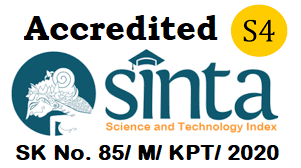Analysis of Energy Efficiency in the Sugar Production Process at PT Madubaru
(Case Study: PG Madukismo)
Abstract
PT Madubaru is a company that produces granulated sugar, spritus and alcohol. Granulated sugar is the main product produced by PT Madubaru. This study aims to analyze the energy efficiency of sugar production at PT Madubaru during the production period of 2022. The analysis of energy efficiency in the production of granulated sugar using the Energy Productivity Ratio (EPR) method shows that in the 2022 production period which runs from May to October 2022, The EPR obtained in the months up to October 2022 shows an EPR value for electricity of 1.2 to 2.44, while for boilers it is between 1.68 and 2.45. The EPR results obtained in each period are in May 2022 with an EPR on electricity of 1.2 while the boiler is 1.16, the EPR in June 2022 is 1.72 electricity and the boiler is 1.68, the EPR in July 2022 on electricity is 1 .93 and the kettle is 1.92, the EPR in August is 1.98 electricity while the kettle EPR is 1.98, in September 2022 the electricity EPR is 2.14 while the kettle is 2.14, in October 2022 the electricity EPR is 2.44 while the kettle 2.45.The highest energy input used during the sugar production period in 2022 is sugarcane with an energy value generated of 431,885,993.55 MJ for electricity and 6,544,947,856.93 MJ for boilers. Based on EPR analysis, energy use in sugar production at PT Madubaru is still feasible.
References
Birru, E. et al. (2016) ‘A comparison of various technological options for improving energy and water use efficiency in a traditional sugar mill’, Sustainability (Switzerland), 8(12). Available at: https://doi.org/10.3390/su8121227.
Chauhan, M.K. and Varun (2019) ‘Life cycle energy usage and ghg emissions study of a sugar mill in India’, Environmental Engineering and Management Journal, 18(1). Available at: https://doi.org/10.30638/eemj.2019.008.
da Silva, H.J.T. and Marques, P.V. (2021) ‘Heterogeneity in the productivity of sugar-energy mills in Brazil’, International Food and Agribusiness Management Review, 24(3). Available at: https://doi.org/10.22434/IFAMR2019.0143.
Duarte, A. et al. (2018) ‘Proposal of stages by controlling the efficiency analysis in sugar and ethanol mills’, Food Science and Technology (Brazil), 38. Available at: https://doi.org/10.1590/fst.11617.
Gunawan, A. (2018) ‘Production and Productivity Improvement Through Efficiency Sugar Mill.’, International Journal of Advanced Research [Preprint]. Available at: https://doi.org/10.21474/ijar01/6638.
Haryanto, B. et al. (2018) ‘Study on Energy Productivity Ratio (EPR) at palm kernel oil processing factory: Case study on PT-X at Sumatera Utara Plantation’, in IOP Conference Series: Materials Science and Engineering. Available at: https://doi.org/10.1088/1757-899X/309/1/012043
Haryanto, B. et al. (2019) ‘Study on Energy Productivity Ratio (EPR) on Pre-Factory Design of Glucose Syrup at Riau Indonesia’, in IOP Conference Series: Materials Science and Engineering. Available at: https://doi.org/10.1088/1757-899X/505/1/012073.
Haryanto, B. et al. (2021) ‘Energy Productivity Ratio (EPR) in Producing Aren Sugar from Nira Aren Tree: Traditional Processing’, in. Available at: https://doi.org/10.5220/0009204203560359.
Irvan, Trisakti, B. and Nabilah, Y. (2021) ‘The utilization of mushroom growing media waste as raw material for biogas production: Energy productivity ratio (EPR) study’, in IOP Conference Series: Earth and Environmental Science. Available at: https://doi.org/10.1088/1755-1315/713/1/012060.
Lavarack, B.P. et al. (2004) ‘Improving the energy efficiency of sugar factories: Case study for Pioneer Mill’, International Sugar Journal.
Manoel, A.A.S., Santos, D.F.L. and Moraes, M.B. da C. (2016) ‘DETERMINANTES DO ENDIVIDAMENTO NA INDÚSTRIA SUCROENERGÉTICA BRASILEIRA: ANÁLISE A PARTIR DAS TEORIAS DE ESTRUTURA DE CAPITAL Debt Determinants in Brazilian Sugarcane Industry: Analysis from the Capital Structure Theories’, Organizações Rurais & Agroindustriais, 18(2).
Sembiring, N. and Novita, S.B.P. (2018) ‘Analysis of company operating feasibility using Energy Productivity Ratio (EPR)’, in E3S Web of Conferences. Available at: https://doi.org/10.1051/e3sconf/20187308011.
Srichaipanya, W. and Chuan-Udom, S. (2020) ‘Optimization of milling performance of a sugar mill’, in E3S Web of Conferences. Available at: https://doi.org/10.1051/e3sconf/202018701001.
Umer, M., Mesum, I.U. and Zahid, A.H. (2023) ‘Efficiency Improvement in Sugar Mills; The Role of High-Pressure Boiler Technology in Cogeneration’, MATEC Web of Conferences, 381. Available at: https://doi.org/10.1051/matecconf/202338101001.
Win, T., Sari, D.W. and Haryanto, T. (2021) ‘ENERGY EFFICIENCY OF INDONESIA’S SUGAR INDUSTRY BASED ON ECONOMIC FRAMEWORK: STOCHASTIC METAFRONTIER ANALYSIS’, Jurnal Akuntansi, 11(1). Available at: https://doi.org/10.33369/j.akuntansi.11.1.53-66.

This work is licensed under a Creative Commons Attribution-NonCommercial-ShareAlike 4.0 International License.












